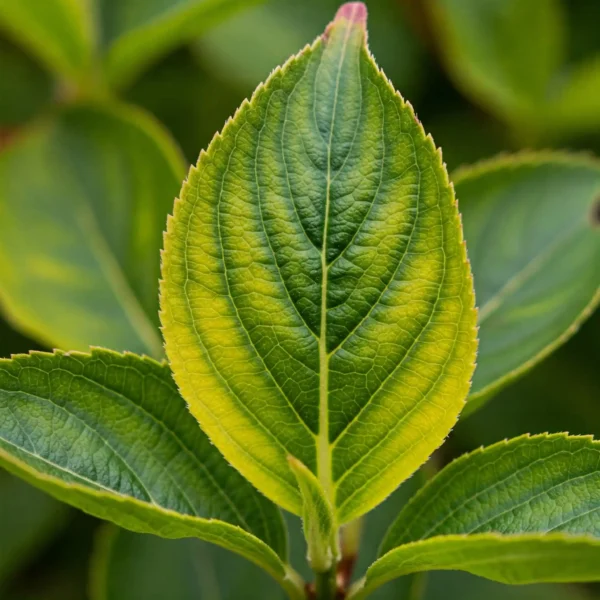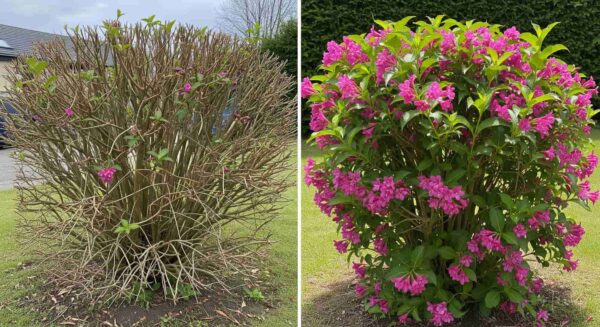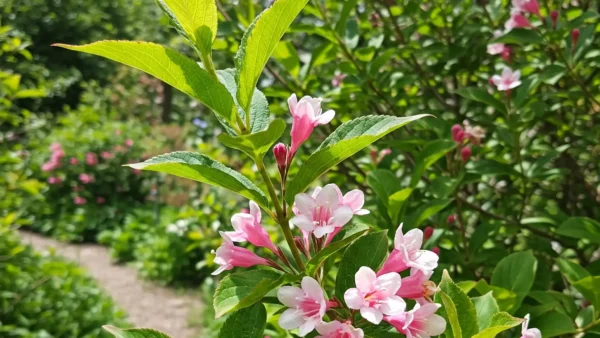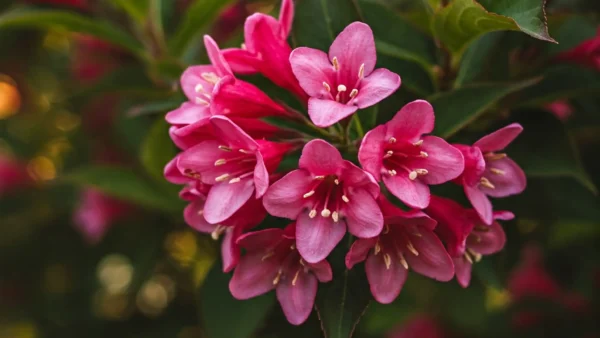Japanese Beetles on Weigela: The Complete Guide to Stopping Skeletonized Leaves
TL;DR
- Identify the Pest: The culprit is the Japanese beetle, a half-inch long insect with a metallic green head and copper-colored wings. The key identifier is five white tufts of hair on each side of its abdomen. The damage they cause is “skeletonized” leaves, where only the veins remain.
- Understand the Life Cycle: The problem is a two-front war. The adult beetles eating your Weigela in summer came from grubs that were feeding on your lawn’s roots in the spring and fall. To win, you must treat both the adults on the shrub and the grubs in the lawn.
- Immediate Action: The most effective immediate control is hand-picking the beetles off the plant in the morning and dropping them into a bucket of soapy water.
- Long-Term Prevention: The best long-term strategy is to control the grubs in your lawn. Use beneficial nematodes in late summer for fast action or apply Milky Spore for slow-acting, long-term (10+ years) protection.
- Avoid Pheromone Traps: These traps often attract more beetles to your yard than they capture, potentially making your infestation worse.
You took the time and effort to develop a magnificent Weigela, and you love how its trumpet-shaped blooms bloom in the spring and how deep green its leaves are. But when summer comes, a terrible new visitor shows up, almost immediately. The leaves of your shrub, which used to be full and healthy, now have holes in them that make them look like delicate, frayed lace. This is clearly the work of the Japanese beetle, a beautiful but hungry bug that can strip a cherished shrub of its leaves in no time, converting a season of promise into one of frustration.
You are in the proper place if you are dealing with this annoying invasion. This article is meant to be the best source of information for keeping your Weigela safe. We’re going to do more than just give you a list of sprays. We’re going to show you a full battle strategy that will kill the beetles on your shrub and find their hidden source under your lawn. You can stop the harm, stop new infestations, and bring back the health and beauty of your landscape by learning about the pest’s biology, its whole life cycle, and a systematic, integrated way to control it.
First, Find Your Enemy: How to Tell Japanese Beetles Apart and What They Do
The first step in any good pest management plan is to correctly identify the pests. The Japanese beetle (Popillia japonica) is a unique bug, so it’s easy to tell if you were right and how it differs from other garden pests.
The shell of an adult Japanese beetle is rigid and oval-shaped, and it is roughly half an inch long. In the sunlight, its head and thorax (the part behind the head) shine with shades of blue and bronze. The covers of its wings have a coppery-bronze color that stands out. There are five little, white tufts of hair, called setae, running down each side of its belly, with two more on the back tip. These are the most clear signs that it is what it is. There is no other beetle in North America that has this same mix of colors and patterns.
The harm they do is also very typical. Skeletonizers are Japanese insects. They descend on a leaf and carefully scrape away the soft green tissue (the parenchyma) between the veins with their chewing mouthparts. This leaves behind the harder, fibrous network of veins. The leaf looks like a lace or net and goes brown quickly, dies, and doesn’t help the plant make food through photosynthesis. This kind of damage is a clear evidence that Japanese beetles are at work.
Why choose Weigela? Getting to Know the Attraction
You might see Japanese beetles swarming your Weigela but not touching a lilac or forsythia next to it. This isn’t random; it’s science. Japanese beetles eat a wide range of plants, yet they have specific tastes. They are reported to eat over 300 different host plants. Plants release volatile organic compounds (VOCs), which are the main reason they are attracted to them. You may call these the plant’s own “scent.”
For Japanese beetles, the unique chemical signature that plants like roses, lindens, grapes, and Weigela give off is like a “dinner bell” that tells them a tasty and healthy meal is coming. When a plant is stressed, like when it doesn’t get enough water or nutrients, it can also release other VOCs that show it is weak, which makes it even more appealing to pests.
Expert Tip: Japanese beetles usually start eating at the top of the plant and work their way down. They are most active in full sun. They also want to be around other animals, which means they eat in groups. The smell of a broken leaf and the pheromones that beetles emit while they eat attract even more insects to the same place. When you detect lacy leaves on the uppermost branches, it’s time to start your control plan right now, before a full-blown swarm comes down.
The Two-Front War: Learning About the Life Cycle of the Japanese Beetle
To really get rid of Japanese beetles, you need to combat them on two fronts: the adult beetles who eat your plants in the summer and the grubs that live in your lawn the rest of the year. If you don’t deal with the grubs in your lawn, it’s like attempting to clean up a flooded floor without turning off the faucet; you’re merely dealing with the symptom, not the cause.
This is the full lifecycle that lasts a year and needs to be stopped:
- Mid-Summer (July and August): The harm is most clear. Adult beetles are at their height right now. They are eating the leaves of your Weigela, mating, and emitting aggregation pheromones that draw in additional beetles. The females will fly down from the bushes to grassy places that are watered, like a well-kept lawn, every so often to lay their eggs just below the surface of the earth. In her lifespan, a single female can lay up to 60 eggs.
- Late Summer to Early Fall (August to October): The eggs hatch into small, white, C-shaped grubs. These grubs start eating the soft roots of your grass right away. This is the best time and first time to treat grubs. They can do a lot of damage to your lawn as they eat and grow through different phases of molting (instars). This can leave patches of brown, dead grass that can be peeled back like a carpet.
- Winter (November to March): As the temperature of the soil drops, the third-instar grubs, which are now bigger, dig deeper into the soil, usually 4 to 8 inches, to spend the winter below the frost line in a dormant state, protected from the cold.
- Spring (April-May): The grubs move back up into the root zone of your lawn as the soil warms up and start eating a lot of grass roots again. This is the second time to treat the grubs, but it doesn’t always work as well because the grubs are bigger, tougher, and will soon stop eating to pupate.
- Early Summer (June): The mature grubs pupate in the ground after their last meal, turning into adult beetles. They then come up from the ground, usually in huge groups over the course of a few weeks, fly to the nearest plant you want, like your Weigela, and the whole cycle of destruction starts again.
From what I’ve seen, the best long-term way to get rid of grubs in your lawn is to do it in late summer, usually in August in most northern regions. At this point, the grubs are small, immature, close to the surface, and eating a lot, which makes them very easy to kill using biological treatments like helpful nematodes or milky spore.

Japanese Beetles: An Integrated Pest Management (IPM) Strategy
A good plan has a pyramid of methods, from easy cultural practices to targeted sprays, that are deployed in a logical order. This Integrated Pest Management (IPM) method is better, cheaper, and better for the environment than just using a chemical spray when you see a problem.
Level 1: The Base Level of Mechanical and Cultural Controls
This is your first line of protection, which includes smart garden design and getting rid of pests. These methods take a lot of work, but they work really well and don’t hurt the environment at all.
- Hand-Picking: This is the best and quickest way to get rid of adult beetles. The best time to do this is early in the morning when it’s cool and the beetles are slow and their wings are still wet with dew. This makes them less likely to fly away. Just hold a jar with a wide mouth and soapy water beneath a branch and tap it. The insects’ tendency is to plunge straight down into the jar to protect themselves. The soap breaks the surface tension of the water and makes sure they drown rapidly.
- Trap Crops: This is a planned distraction. In a distant region of your yard, at least 20–30 feet away from your cherished shrubs, plant a “sacrificial” crop that Japanese beetles like even more than your Weigela. Zinnias, African marigolds, or evening primrose are all good choices. The goal is to get the beetles to gather in one place that is easy to manage. This will make it easier to select them by hand and move most of them away from your Weigela.

Level 2: Biological Controls (Using Nature to Fight Nature)
This level is all about getting rid of the grubs in your grass so that they don’t grow into adults the next year.
- Milky Spore (Paenibacillus popilliae): This is a bacterial disease that happens naturally and kills Japanese beetle grubs. It doesn’t hurt any other living things, including pets, wildlife, helpful insects, and people. A grid design is used to put the powder on the lawn. As grubs eat roots, they take in the spores, get sick, die, and break down, releasing billions of new spores into the soil. This is a long-term plan. It can take 2 to 4 years to get the soil’s spore concentration high enough for it to work, but once it does, it can protect the area for 10 years or more. It’s a way to make your soil healthier.
- Beneficial Nematodes (Heterorhabditis bacteriophora): These tiny roundworms are parasites that hunt down and kill grubs in the soil. You have to treat them like living things because they are. You mix them with water and spray them over the grass, usually at night to keep them from breaking down in the sun. The soil must be wet before and after applying nematodes so that they can move through the pores of the soil. The temperature of the soil must also be above 60°F (15.5°C). The best time to apply is in late summer, when the grubs are still young and weak.

Level 3: The Big Trap Debate: Do Pheromone Traps Really Work?
This is one of the most talked-about issues in the fight against Japanese beetles. The bright yellow traps use a strong mix of a floral aroma lure (to attract both sexes) and a strong synthetic sex pheromone (to attract men). The problem is that they work too well to get insects to come.
Many investigations at universities have demonstrated that the traps’ strong attractants bring in a lot more beetles from the area than they actually catch. Putting a trap in your yard is like putting up a huge neon sign that reads “Free All-You-Can-Eat Buffet Here!” for every bug within a quarter-mile. They fly toward the trap, but a lot of them will stop at the tasty-looking plants nearby, like your Weigela, before they get there. For this reason, most university extensions and entomologists strongly warn against using them in a typical home garden because they are quite likely to make the total number of beetles and the damage to your plants worse.
If you really have to employ a pheromone trap, the best way to do so is to get everyone in the community involved. Get together with all of your neighbors and put traps along the edges of all of your properties to keep the beetles away from your gardens. Putting one trap in one yard is nearly always a bad idea that will make your problem worse.
Level 4: Sprays made from plants and chemicals (the last resort)
You should only use these when the infestation is very bad and could affect the plant’s health.
- Neem Oil: This is best used to keep things from happening. Azadirachtin, the active component, stops growth and makes things less appealing to eat. It makes the leaves taste bad and stops insects from molting correctly when they eat it. It doesn’t kill mature beetles right away.
- Insecticidal soap: Works by breaking down the waxy upper layer of an insect’s skin, which makes it lose water. It works well on pests with soft bodies, but not so well on adult beetles with hard shells. It has to touch something directly to work.
- Conventional insecticides: Products with active chemicals like carbaryl or pyrethroids will kill Japanese beetles when they touch them. These poisons, on the other hand, are broad-spectrum and will kill helpful insects like bees, butterflies, and the predators that keep other pests under check. They should only be used as a last resort to save a young, weak plant from losing all of its leaves, and they should always be administered in the late evening when pollinators are not active to limit damage to other plants.
The best way to protect your Weigela is to make it strong.
A plant that is healthy and strong can better handle and recover from damage caused by pests. A plant that is under stress is a target. Your goal should be to keep your Weigela as healthy as possible so it can handle the feeding that will happen.
- Correct Watering: A plant that is stressed by a lack of water sends out chemical signals that pests find very appealing. It also doesn’t have the resources to repair damaged tissue. To help your Weigela develop a strong, deep root system that can locate moisture even when the surface is dry, water it deeply but not very often (once a week during dry periods is a good time).
- Balanced Fertilizing: In the early spring, use a slow-release fertilizer made for shrubs that is balanced. Don’t give your plants too much nitrogen, as this can make them grow weak and sappy, which is very soft and tasty for chewing insects. A balanced N-P-K (Nitrogen-Phosphorus-Potassium) ratio helps plants stay healthy, including their roots and their ability to handle stress.
- The optimal time to prune a Weigela is just after it blooms in late spring or early summer. Cutting back some of the older, heavier canes near the base of the plant will let more air and light into the heart of the shrub. This not only lowers the chance of fungal illnesses, but it also makes the plant less dense and less welcoming for pests to hide in.
Conclusion
To win the war against Japanese beetles on your Weigela, you need to change your tactics from a one-time battle to a year-long campaign. It needs a plan on two fronts: one for the adult beetles who eat the shrub in the summer and another for the grubs that grow in the lawn all year. You can stop the cycle of infestation, secure your landscape investment for years to come, and limit damage by combining smart cultural practices like hand-picking with strong biological controls in your turf and focusing on growing a stronger, more robust Weigela.
Frequently Asked Questions
Will the damage from Japanese beetles harm my Weigela?
Even if a Weigela loses a lot of leaves, it probably won’t die if it is mature and healthy. It mostly has to do with how it looks, but it also makes it harder for the plant to store energy for the next year. But a severe infestation can make a young shrub, one that has just been planted, or one that is already stressed weak enough to be more likely to get sick or be damaged in the winter.
When do Japanese beetles come out the most?
They are most active when it is warm, usually from mid-morning to late afternoon, especially on sunny, warm days. They move slowly and are simpler to catch in the cool of the early morning.
Are there any kinds of Weigela that Japanese beetles can’t eat?
Sadly, none of the Weigela types are really resistant to Japanese beetles. Some Weigela may be a little less popular than others, but if there are a lot of beetles in your region, all of them are at risk of getting hurt. Choosing a variety isn’t the best way to protect yourself.
Are there any natural enemies of Japanese beetles in North America?
Yes, but not enough to keep their numbers in check. Birds like starlings and grackles will eat them, and some native flies and wasps, such the Winsome Fly, may attack them. But the Japanese beetle is an invading species, so it doesn’t have the strong network of specialized predators that keeps it in control in Japan.
How long does the season for Japanese beetles last?
In most northern regions, the adult beetle season lasts around 6 to 8 weeks, starting in late June or early July and ending in mid-to-late August.
What sets Milky Spore apart from helpful nematodes?
Milky Spore is a bacterial disease that only hurts Japanese beetle grubs. It takes years for it to develop up in the soil. Beneficial nematodes are tiny worms that eliminate many kinds of pests that live in the soil, like grubs. They operate quickly (in one season) but may need to be applied again every year.









